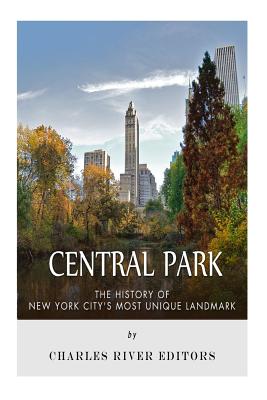Central Park: The History of New York City's Most Unique Landmark

Central Park: The History of New York City's Most Unique Landmark
*Includes pictures *Includes accounts of the park's construction and history written by newspapers and people who worked on it. *Includes a bibliography for further reading *Includes a table of contents "I just want to go through Central Park and watch folks passing by. Spend the whole day watching people. I miss that." - Barack Obama Of all the great cities in the world, few personify their country like New York City. As America's largest city and best known immigration gateway into the country, the Big Apple represents the beauty, diversity and sheer strength of the United States, a global financial center that has enticed people chasing the "American Dream" for centuries. Given that background, it's fitting that the city's most unique landmark, Central Park, sits at the heart of Manhattan and provides a stark contrast to the hustle and bustle surrounding it. As actor Haley Joel Osment once put it, "My favorite place is Central Park because you never know what you're going to find there. I also like that when I look out the windows of surrounding hotels, it's seems like I'm looking out over a forest." In 1811, an ambitious plan was laid out that would transform Manhattan's grid into 2,028 blocks, from Houston Street to 155th Street. Forests would be cut down, hills razed, ponds and streams filled. It took years to survey, and years to complete: at different points in time, one might have seen a long avenue laid out, unpaved, with a scattering of as-yet-unattached six-story buildings amid boulders yet to be cleared and soon-to-be-demolished shantytowns. Ironically, almost no parks were incorporated into the plan, and Central Park would not be built until the end of the 19th century. When Central Park was designed, however, it was an ambitious project on an almost unprecedented affair. As serene as Central Park is today, it's hard to imagine that its creation was an entirely manmade affair consisting of dynamite blasts, tons of imported topsoil, and the labor of thousands of workers. Before the area's transformation, the land was swampy terrain used by impoverished squatters and people who let their livestock roam the grounds, but after nearly 15 years of work, the metamorphosis was nearly complete. Of course, New Yorkers soon came to understand that such a large park required serious upkeep; as historian Robert Caro noted, "Lawns, unseeded, were expanses of bare earth, decorated with scraggly patches of grass and weeds, that became dust holes in dry w
PRP: 56.11 Lei
Acesta este Pretul Recomandat de Producator. Pretul de vanzare al produsului este afisat mai jos.
50.50Lei
50.50Lei
56.11 LeiLivrare in 2-4 saptamani
Descrierea produsului
*Includes pictures *Includes accounts of the park's construction and history written by newspapers and people who worked on it. *Includes a bibliography for further reading *Includes a table of contents "I just want to go through Central Park and watch folks passing by. Spend the whole day watching people. I miss that." - Barack Obama Of all the great cities in the world, few personify their country like New York City. As America's largest city and best known immigration gateway into the country, the Big Apple represents the beauty, diversity and sheer strength of the United States, a global financial center that has enticed people chasing the "American Dream" for centuries. Given that background, it's fitting that the city's most unique landmark, Central Park, sits at the heart of Manhattan and provides a stark contrast to the hustle and bustle surrounding it. As actor Haley Joel Osment once put it, "My favorite place is Central Park because you never know what you're going to find there. I also like that when I look out the windows of surrounding hotels, it's seems like I'm looking out over a forest." In 1811, an ambitious plan was laid out that would transform Manhattan's grid into 2,028 blocks, from Houston Street to 155th Street. Forests would be cut down, hills razed, ponds and streams filled. It took years to survey, and years to complete: at different points in time, one might have seen a long avenue laid out, unpaved, with a scattering of as-yet-unattached six-story buildings amid boulders yet to be cleared and soon-to-be-demolished shantytowns. Ironically, almost no parks were incorporated into the plan, and Central Park would not be built until the end of the 19th century. When Central Park was designed, however, it was an ambitious project on an almost unprecedented affair. As serene as Central Park is today, it's hard to imagine that its creation was an entirely manmade affair consisting of dynamite blasts, tons of imported topsoil, and the labor of thousands of workers. Before the area's transformation, the land was swampy terrain used by impoverished squatters and people who let their livestock roam the grounds, but after nearly 15 years of work, the metamorphosis was nearly complete. Of course, New Yorkers soon came to understand that such a large park required serious upkeep; as historian Robert Caro noted, "Lawns, unseeded, were expanses of bare earth, decorated with scraggly patches of grass and weeds, that became dust holes in dry w
Detaliile produsului









